Tending a garden can be a lot of work, but it is a pleasured pastime for many, and growing consumable plants is a way of life for others.
However, to maintain a healthy garden, you require plant food, and fertilizer can be expensive and dangerous. Thankfully, there is a nutrient-rich fertilizer that you can easily make at home with little effort or experience.
This article highlights how to create comfrey fertilizer. The process is relatively easy and has a significant impact on the health of your garden.
Comfrey: Identification And Benefits
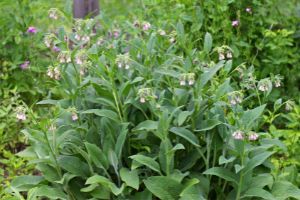 Comfrey is a shrub known to grow throughout Europe, Asia, and North America. It can grow up to 5 feet tall and produces small clusters of flowers that are often blue, white, or purple.
Comfrey is a shrub known to grow throughout Europe, Asia, and North America. It can grow up to 5 feet tall and produces small clusters of flowers that are often blue, white, or purple.
Comfrey leaves are long and slender, with many gardeners choosing comfrey for its use as plant food.
This fantastic plant is rich in moisture and can be used as a living mulch in your garden. Dead leaves from a comfrey plant will release their nutrients onto the topsoil, allowing other plants with smaller roots to benefit.
Related: 10 Edible Roots That Kept This Hermit Monk Alive
Thanks to its deep root system and ability to draw nutrients, comfrey makes an excellent fertilizer. In fact, it is so good that many gardeners will grow comfrey to encourage the growth and health of other plants.
Fertilizing Your Plants
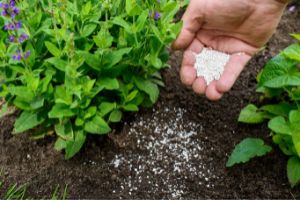 If you have ever purchased a plant at a store, you probably noticed the white specks in the soil. These white specs are fertilizer. Fertilizer ensures the plant looks strong and healthy on the shelf.
If you have ever purchased a plant at a store, you probably noticed the white specks in the soil. These white specs are fertilizer. Fertilizer ensures the plant looks strong and healthy on the shelf.
Unfortunately, the fertilizer embedded in the plant’s soil will dissipate with time, leaving it with fewer nutrients.
Many people add fertilizer to the soil of their plants to help them grow. There are many different fertilizers, and choosing one can quickly become overwhelming.
Thankfully, you can create fertilizer at home. Although many things can be used to fertilize greenery, not many work the way comfrey does.
Due to its expansive root system, comfrey can pull substantial amounts of nutrients from deep within the earth.
These nutrients are one of the reasons that comfrey grows so well, to the point of being invasive at times. While this can be frustrating, comfrey can be used to build a robust garden.
⇒ Learn How To Make A Year-Round Self-Sustaining Garden
There are several ways that comfrey can be used in your garden, and you may want to consider adding some to your plant collection.
Here we outline a few of these methods and show you how to create comfrey fertilizer that will aid garden health.
How To Harvest Comfrey:
Before making fertilizer, you need to get the product. Comfrey grows freely in many places throughout North America. However, if you cannot find it, you can purchase a comfrey plant at a garden center or online.
Comfrey can be harvested twice in the summer. To harvest, cut the plant down to the base with garden shears, leaving the root and lower stalk behind for regrowth.
I suggest wearing gloves as comfrey is covered with prickly hairs that can irritate the skin. Many people will cut the remaining leaves into smaller pieces to encourage decomposition.
The Chop And Drop Method:
The chop and drop method of fertilizing with comfrey is precisely as it sounds. You will cut off the plant’s leaves and drop them on the ground, allowing them to break down and create a natural mulch.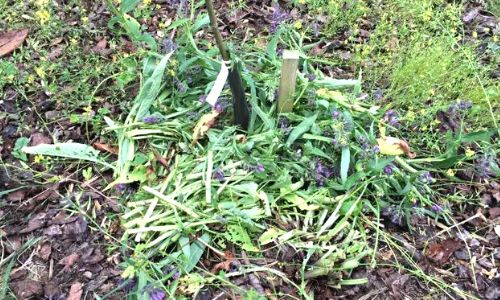
This method of fertilization is by far the easiest and requires the least effort. The downside of the chop and drop method is that the leaves’ remnants will only benefit plants nearby. Still, this is an excellent option for small gardens or areas where plants are close together.
An Amazing Comfrey Compost:
Adding cut comfrey leaves to your compost pile will create nutrient-rich soil. The rich nutrients within the comfrey plant will make their way to the compost pile and onto other plants, creating a healthy, bountiful garden.
⇒ This Hidden Survival Garden Will Keep You Well Fed When SHTF
When using comfrey leaves as compost, you must rotate and sift the soil often to allow the leaves to break down faster and the nutrients to mix evenly into the earth.
A Simple Comfrey Tea:
Creating comfrey tea for your garden is a relatively straightforward process with many benefits. This mixture will allow the rich nutrients from the comfrey plant to quickly reach the roots of the other plants in your garden.
1. Gather the leaves of the comfrey plant.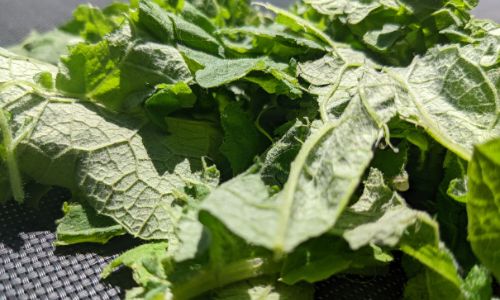
When creating comfrey tea, you must use only the plant’s leaves; this will help the mix break down faster. The leaves of the comfrey plant should be harvested before flowers form for best results.
You should remove the stalks and stems, keeping only the soft part of the leaves.
2. Place the harvest in a large bucket with a lid.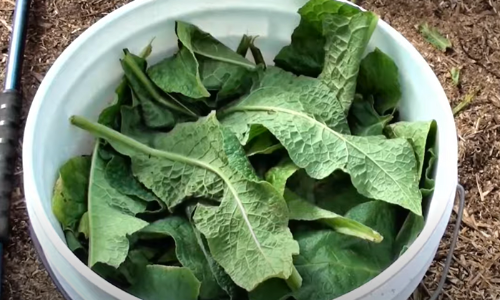
Grab a large bucket with a lid and pile the comfrey leaves you have harvested inside.
Related: How To Harvest These Seeds For SHTF
Some gardeners prefer using store-bought buckets with a spout to quickly drain the fertilizer when it is ready.
3. Add water.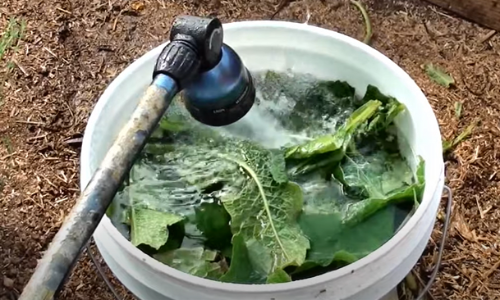
Cover the comfrey leaves with water and place something heavy on them to keep them submerged. Cover the bucket with a lid and let it ferment.
Comfrey liquid fertilizer will smell very bad. A tight-fitting lid will prevent the smell from seeping out and speed up the decomposition process.
4. Store and wait.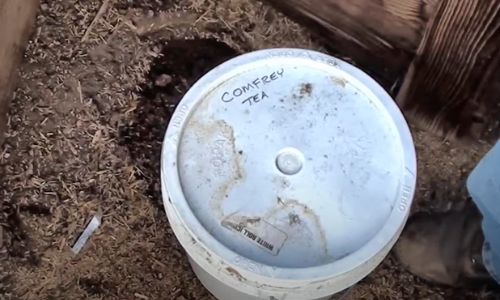
It will take time for the leaves of the comfrey plant to break down. Be patient; an exciting process is taking place inside the bucket, and all the valuable nutrients within the comfrey plant are being broken down and released into the water.
5. Dilute and use.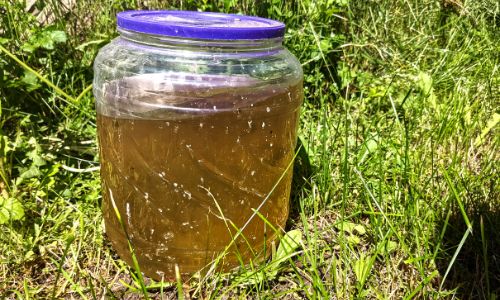
Once the comfrey leaves have broken down, which will take around 4-6 weeks, you will dilute the mixture with water in a 10:1 ratio. This step is vital.
Note: Using comfrey fertilizer without properly diluting it will damage your plants.
How To Create A Comfrey Leaf Mold
Since comfrey will turn to liquid as it decomposes, it cannot be used on its own to create a leaf mold. Still, comfrey is rich in nutrients and is an excellent addition to any leaf mold pile.
Gather fallen leaves and place them in a wire or wooden bin. Alternatively, you can pile the fallen leaves in the corner of your lot if you prefer.
If you use a container, ensure it is at least 3 feet wide and 3 feet tall, or create a pile close to this size. Once you have gathered all your leaves and placed them in a pile or container, dampen them with water and ensure they remain moist.
You can use a garbage bag to create leaf mold as well. To do this, fill a garbage bag with leaves. Poke air holes in the bag, and moisten.
Let the pile, container, or bag sit and rot. This process can take up to two years, so be patient. Eventually, you will have a nutrient-rich leaf mold that you can use in your garden as mulch or by mixing it into the soil.
Adding comfrey to a leaf mold pile helps keep it moist and provides extra nutrients that may not be available in other plants. Comfrey truly is a great gardening tool.

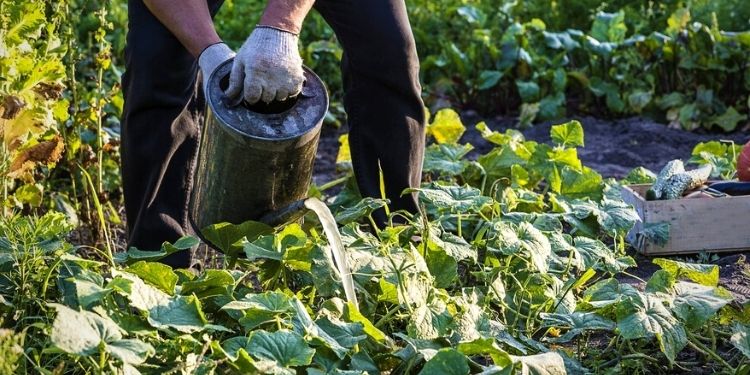













Yeah. Unfortunately, this websites viewing participants have difficulty affixing shoes to their feet unless it has velcro. I’m guessing some of the older boomers could just pay a mexican to do the manual stuff. Great article by the way. Very creative.
To all. please do not post back to this loser. we all know “it” is here to do the “devil’s work”.
Be better then this thing. Don’t post to “it”…
By posting back to this ?… we lose valuable time learning to prep.
Hey, freaky frankie, never forget, every time you aim that find at someone, there’s 3 aiming back at you. We call it the poloc (American Indian for rotting brain cells). Me, I go work for the Mexican and he loves that while I’m far older I can keep up easily. Secret is, sleep in! do not get up before 4:30 AM. Do 10 or 20 touch the toes. Then take the dog out, a xolo de pueblo (Mexican dog best known for able to live wild and considered most deadly dog), who thinks racing everywhere is fun. that’s cool. e’s a lot nicer than the dachshunds we owned. Go to work in the garden. I like to dig new beds. 3 deep deep, 3 across and maybe 20 long. Our adobe has a problem with caliche. When that’s done, take the truck and find nice logs and brush to pack in it, then put the adobe back, wash it in, and cover with heavy mulch. Mind, do not bury Mouser the rattler. She’s a valued part of the garden. she keeps her fangs to business, not me, and I don’t eat toasted devil worm on a stick. By 10 at this time of year, it’s in the 90s and little warm to work much, so I take it easy and wear a wet tee shirt when I work. Sorry, no can take a horse out in this to check cattle and fences. It’s too hot for them. By 6 PM, it’s time for the first meal of the day. I like Chinese, Vietnamese, German, and pretty much anything that doesn’t try to eat me first. Do emails, research for novelists and so on. Study some psychology and to me, any research is fun. But then, I’m 65 and learned to love learning. hasta, kid.
A pretty good article. Comfrey has many uses beyond mentioned here. Worth researching.
I grow Russian Block 14 sterile seed comfrey as comfrey is very invasive. I have to manually split the roots to plant it elsewhere. Excellent pollinator attractant early spring into summer.
An excellent booster to a compost pile that’s just sitting there. I give it my rabbits as a nice pick me up treat especially nursing does.
Oddly since I added it to my apple tree guilds, I’ve noticed two things. My winter deer damage was nearing zero for two winters now (Good). But a very young apple tree seemed overwhelmed by its vigorous growth, so I am cutting that comfrey heavily as chop and drop. Maybe I can save that tree. Might be that tree simply failed to thrive as before comfrey it was a little wimpy.
I use comfrey fo many things. Lotions, creams and tinctures. It is good for outside and inside!
I found a great video on YT for *identifying* comfrey. Very important to novices like me. YouTube
I have had comfrey for many years for its beauty and purple flowers. Now, to find out how useful it is as well because of this article. Thank you so much.
I have a rather weedy yard, and I’ve been gradually trying to organically reduce the number of larger weeds that I don’t want to propagate. I doubt that I have comfrey growing out there, but I will observe the leaves of all the weeds to make sure I don’t eradicate something useful. I was sad when my husband tilled up an area where I had discovered a Star of Bethlehem plant. Oh well. He isn’t very interested in botany or learning about plants. I did get a few purslane growing in my veggie garden! It is so tricky to identify plants!
My sister in Penna asked if I wanted a lawn mower. I said why? I live in southern Arizona and if I see a blade of grass, I run for the shovel and get rid of it. Every weed in the yard has a use. Rosemary, thyme, century plant, wild sunflowers, yucca, rush peas, valerian, and so on. It’s getting crowded out there but all are welcome. niio
I use the majority of my “weeds” as compost, but highly recommend gathering and composting them before they develop seeds, as in, early weeding is best, then toss the immature weeds into the compost pile.
ones to avoid are any grasses or other invasive plants that spread by underground runners, even if they appear “dead”. Once they get water they often revive and continue to grow and infiltrate your entire compost pile.
if you can get HOT compost rolling…. then you got it made. It will dissolve a body in a week.
dz: let them grow. Cut them off and the roots die back, adding to the humus and loosening the soil. when they regrow, do it again. this makes mulch. When they start to bloom, cut them off below the crown to kill them. niio
red, doesn’t work for container gardening, have to pull the weeds and compost them, then use the compost to nourish the containers. ALL grasses get removed down to the smallest piece of root – too invasive, especially Bermuda and crab grasses. I do have a couple of “weeds” that work well as a ground cover in some containers to help reduce the soil drying out, but the majority get pulled and composted.
Actually with container gardening black plastic is your friend with crabgrasses.
After you harvest or before you plant the crabgrass contaminated container wrap it in black plastic and set in the hot sunshine. In about a week to 10 days depending on the size of the container and the heat of the sun you should have nearly sterilized soil.
Technique is called solarizing. Even works decently on regular raised beds although just the top few inches of soil due to the mass of soil to be heated.
I’m too busy to fight crabgrass.
dz: I should have said in-ground gardens, sorry. we don’t get a lot of weeds in the tubs. Usually wild mallow. Some folks like the roots and greens. I pull up the mulch with a pitchfork and drop it over the weeds, which makes them fertilizer. Right now, all aquaponic units are being dismantled and drained. Something dug into a basket (3″) trying to get to the water of a big Kratky unit. When I checked the level, it was full of mosquitoes, so that now has wriggler bait in it and is sealed for a week. Next time, it’;s getting bait (floaters) right from the git go. Mosquitos make better fertilizer than friends LOL. niio
Michael best thing about crabgrass is it’s a great forage for livestock. Pigs go nuts over the roots. Down here, it’s bermuda grass and that spreads like wild fire. Like crabgrass, one small piece of root means a garden bed full of grass in no time. Bermuda is a good host for mosquitoes. Cardboard works better here because plastic is wrecked by the sun, and roots can pop thru it anyway. Lay out cardboard and soak it well, then allow it to dry out. That helps keep bermuda from breaking thru. niio
In Missouri, the bane of my garden beds is Johnson grass. What a pest!
Karen: Carboard mulch or a calf, either will kill it off. In Arizona it’s listed as a grazing decreaser, It dies out from too much grazing and everything will chew on it. Here. it’s a wiregrass, bermuda that wrecks things. niio
ah, a Troll by another “name” of DZNUTS, and not very creative either. new name, same old BS
No comfrey around. But, we have other things that bees like. The Native American herbal handbook, Baja, is a good source. And, this is a good start. niio Herbs, Plants, and Healing Properties
Red, thank you for linking that web site. I have visited a few times in the past reading the historical articles. There’s a lot of information there. I have a copy of “Native American Heralism Bible” by Aiyana Catawnee. Very interesting reading. I’m reading the books by Bobby Lake-Thom now. I really have to wonder why the Europeans didn’t acknowledge those who were here first, more.
herbalists did. Most of our original Materia medica (from the feds) lists where the herbs were used and how. The federal government published revised copies up till the AMA took over and had herbalists jailed for practicing without a medical license. niio
Thank you, a very helpful and informative article helped by the photos.
Will be adding Comfrey in a raised bed and using it in a rotary compost bin.
Just so you know, it will takeover the entire bed.
Love the article, thank you!
Comfrey does poorly in hot climates. I have killed more plants than I care to remember. Bocking 14 survived the longest but it succumbed as well in the end. I’m told nettle tea is also very good for plants and soil but it doesn’t do so well here either.
Our dung beetles have been extraordinarily successful this year so there is little cow manure so I’m down to the alpaca poo which fortunately for me is concentrated in several spots around the field and easy to pick up.
We all use what we can find.
Ginny- I live in the deep south Fort Myers to be exact and I’ve had great success growing comfrey in our hot climate, the majority of my comfrey is planted in somewhat shady areas with filtered light, maybe that’s the key. you should give it a try and see if you have success.
Borage leaves can be used similarly as the Comfrey for liquid fertilizer. Just hold your nose when you lift the lid on the bucket you have been brewing your concoction in, if you leave it too long. A few years ago, I plant just a small patch of Borage. It took off and planted itself everywhere. The seeds have a tendency to “pop” out. It is a drought tolerant plant and the bees love the little purple blossoms. (I don’t use chemical herbicides.) The leaves are useful as a tea. The purple blossoms can frozen in ice cubes if you make iced tea with the leaves. Borage is an ingredient in various hair care products.
Ginny, I moved from a wet coastal temperate climate to a hot dry area. It stays hot and dry for much of summer. It isn’t unusual to have temperatures above 90 that sometimes go above 100. I haven’t seen any Comfrey around here, nor have I seen any Nettles. I don’t miss the Comfrey but I do miss not being able to go into a wooded area for Nettles. Nettles are great as a spring tonic in soup or cooked like spinach. When a relative had his mouth burned by the inept use of the cancer treatment machinery. He was given tea with fresh nettles in it every morning. It helped heal the open wounds created by the machine.
I am impressed with the industriousness of your dung beetles! I had no idea that they were so busy. One of my siblings made the mistake of loading up her SUV type car with alpaca poo and then taking the long drive home which included sitting on the ferry. She was just about dizzy from the fumes by the time she got home. But, alpaca poo does the job.
Sage: may it rain! We’ve been getting micobursts, which make the Mexican nopales (domesticated for large pads and fruit) sprout again. Not a lot of fruit, but hardly any rain last winter, either. The mesquite is still dropping the first harvest and already blooming for the 2nd. If I can keep birds from eating the tops off tomato and chili seedlings, they’re do very well. Most don’t make fruit till later in July but those already in the garden are! Did you dig swales to hold runoff? niio
Ginny: No comfrey here, either. We do well with canna, tho. Dung beetles are awesome. no other term for it. Australian are the best in AZ, and will attack even dried out, cold manure. niio
I will try deeper shade and more borage, thanks guys. It’s the long hot and dry that does many plants in here. Sometimes no rain from late October to May and if the dams go dry that’s no water for half that. That’s only happened twice in 30+yrs so rare. The heat can be days n weeks on end over 40C and a good sprinkling of temps over 45C. Bearable if the winter was a good one but Christmas 2020 followed a very dry winter and I lost just about everything in the garden other than established trees, globe artichoke, asparagus and rosemary on the north side of the house. The south side is more protected so I only lost a new apple and a linden tree and some of the small plants. The valerian and comfrey didn’t survive and a couple roses passed on also.
Red, my arrowroot cannas survive well with a bear minimum of summer water. We are having a wonderful winter with some rain each week and cool sunny days in between. Unfortunately the weeds have got away from me but I’ve been pulling some each day and feeding them to the stock over the fence. Win win all round. The little mallows are 5ft tall so pull up easily.
Got stock to feed so better get to it. Have a good one everyone
Ginny: 5-foot mallows? wow. Ours never get over 2.5. Did you try the roots? they were once cooked and used for candy. Canna doesn’t like our wind but is in bloom now, and the seed get saved to grind and add to flour. niio
Red, haven’t tried the roots yet but they are doing a great job of breaking up the clay subsoil. The garden will be ready for planting after this week rains. Got some black radish and lots of greens to go in along with carrots n beets. Got some pumpkin started early for when the weather warms up.
Dug up some canna arrowroot yesterday and the starch is nearly dried. Not sure when is the best season for harvesting that for max starch. Is it higher in young or older roots?
Ginny: older canna roots, about 10 months, have the highest starch. The younger they are, the sweeter. A rancher in Brazil, 36,000 acres planted each year in canna. He harvests seeds from acres of seed canna, treats and plants the seed, harvests any seed heads (ground, they’re added to tortillas), then chops the greens, plants a green manure crop, then harvests roots. A month later, feeder cattle and -pigs are grazed for a month, then moved and the filed replanted to canna.
I know of two black radishes, one Spanish, the other German. Both are winter radishes like daikon but spicy. Volunteers are coming up in the garden and they can be harvested or just chopped in Oct or Nov. to make room for green peas. niio
Red, thanks for the info. I had a mix of arrowroot rhizomes so was happy with the amount I extracted. My arrowroot never sets seed, just flowers (small red) over summer. Maybe mine is self sterile and I don’t have others growing around here. Been looking at some for the flower garden for this spring.
That’s a massive amount in Brazil. Obviously they get a lot more rain than we do. No way we could get it growing here like that ??
Ginny, I bought seeds and planted them. Australia (probably up in banana bender country LOL) supplies I think, 25% of Asia’s starch with canna. Are your plants Indian Shot? there are varieties of canna that grow roots half as long as your arm and near as big around without branching or knots. Most research done to the plant for starch is in Australia. My best to you and yours! niio
Red, I bought rhizomes originally but have found arrowroot seed for sale so might buy them and see what I get come up. Currently I have 3 small clumps around the garden but I’m expanding that atm. In spring it will expand rapidly if I water it.
I’ll have to do more research, didn’t know about the starch supply to Asia.
All the best to you and yours too.
Comfrey also has the name of Knit Bone. Make a mash out of the leaves (older ones have accumulated more minerals) and place it on old clean cotton material, wrap to make a poltice and cover bruises and sprains. Try it and be amazed at its healing properties!
Stephanie, Yesterday, I found the value of a poultice. It wasn’t a comfrey poutice but an onion poutice. Something bit my leg and left a red bump with two teeny tiny holes so it might have been a spider. It was itchy. I took a slice of onion about 1/2 inch thick, heated it up in the microwave. I put the onion on the bite when it was still super hot but not too hot to burn my skin. I wrapped a cloth around it to keep it in place and kept it there for an hour. After doing that, the itch was gone and today, there is a tiny little red spot but zero itch. The onion drew out any toxins.
Thanks Lin. Nothing like practical experience! I’ll add that one to the knowledge bank!!
My grandmother always used comfery for bruises she just picked it and mashed it up and used it like a salve
Great article. Yes comfrey has many benefits including as a fertiliser and I particularly like to use if for comfrey tea. However, comfrey does require a significant amount of water.
For chop and drop fertilisation I prefer Cana edulus. Cana edulus requires far less water, produces lots more biomass, and as an added bonus, the tubers are edible.
Leo: I like canna. The new shoots are called Inca asparagus. Roots make the 2nd best cooking starch and the kids got giggle fits when eating ‘invisible’ (glass) noodles made from it. And, naturally, they yacked. We got a few calls from school asking why we’re feeding glass to kids. Then sent packs of them dried to the teachers. niio
How to make glass noodles – much research is now required ??
sounds similar to “bean thread” noodles my wife cooks for pansit. I think they are mainly starch formed into thin noodles.
Ginny, dz, starch, water to mix. Boil water and add noodles. For a dessert noodle, cook in fruit juice, then use the juice for a pie or as a syrup. Cherry nuts can be made, but it’s hard to keep on the starch coating without dipping in egg, then starch back and force. Boil the nets till done then deep fry. Most folks just make dough or use pilo wrappers but, once cooked, wide noodles can be used. niio
It’s funny that psychotics like Raven Piece of Shit and his evil
brother Frank Piece of Shit deMarco don’t rant on other sites.
Must be that the person running this site is No Balls Piece of Shit
*
I am surprised that no one mentioned that comfrey encourages cell division. You don’t want to eat it. It is thought to promote cancer. I have a small patch of a couple plants but I have no real use for it other than the flowers look pretty.